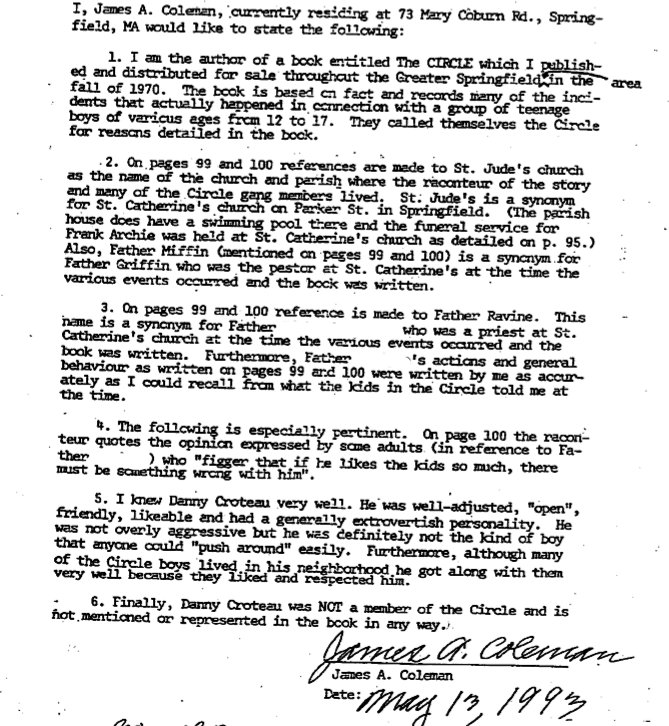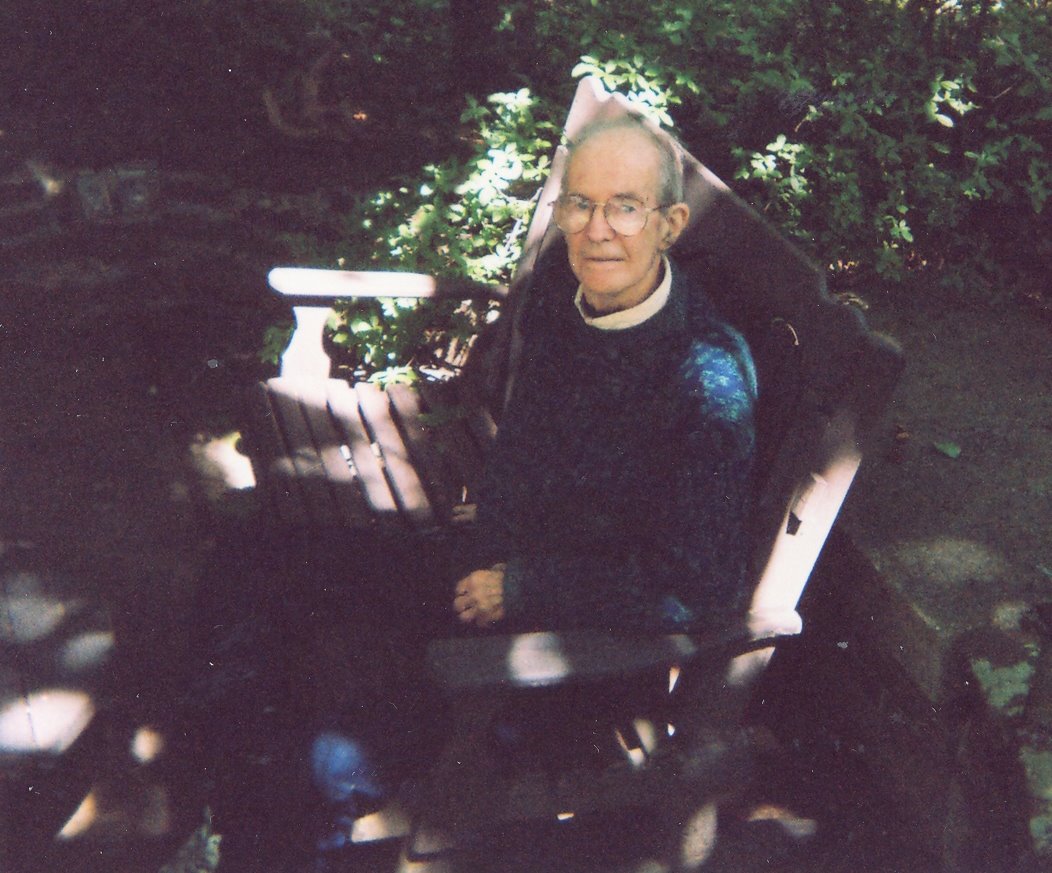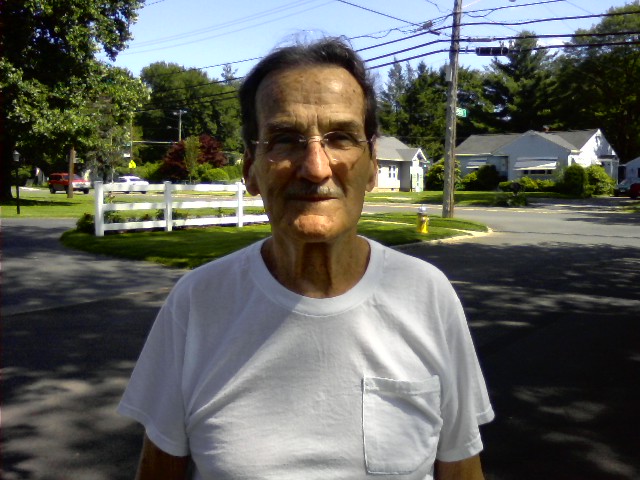Daniel Croteau Murder
July 24, 2009
http://croteaumurder.blogspot.com/2009/07/suspectsand-other-persons-of-interest.html
 |
Above - excerpt from the 1993 affidavit by State Trooper Thomas Daly.
Then-priest Rick Ravine (not his real name-see intro) was—and still is—the only publicly identified suspect in the murder of Daniel Croteau. But he wasn't the only person police investigated in 1972.
In the early days of the investigation, police looked into several suspects, including "a produce manager at a nearby supermarket" whose bedroom Danny was supposed to paint for $10, according to Jim Mitchell, a retired state trooper who was one of the original investigators in the case.
The supermarket employee, along with Danny's Boy Scout troop leader, were questioned, but neither "rose to the level" of suspicion that Ravine did, according to Mitchell. When their alibis were verified, they were ruled out as suspects.
The investigation then focused on Ravine, and for good reason. He attracted police suspicions immediately by showing up at the crime scene the day after the body was found, and then, the following day, asked questions that were "consistent with those asked by the perpetrator of a crime," according to State Trooper Thomas Daly, who investigated the case in the early 1990s. Moreover, one of Ravine's questions was about the possibility of a stone being used in the homicide, even though police had yet to publicly reveal that the murderer had used a rock.
The priest, who police believe molested Danny and three of his brothers, also misled investigators, telling them he was never alone with the boy overnight. They discovered quite the opposite was the case: the two had a close relationship for six years, during which they spent many weekend nights alone together.
However, Max Stern, Ravine's lawyer, has always insisted that police were much too quick to zero in on the priest, writing in a media release in 2008 that "there were a very large number of suspects identified in the case (many noted in the search warrant affidavit) who were never investigated."
Danny Croteau's father, Carl Croteau Sr.—who developed a friendship with the lead investigator in the case in the years after the murder—says that it was his understanding that the other suspects were indeed investigated thoroughly. John Stobierski, an attorney representing Danny's parents, declined to comment on Stern's claim of un-investigated suspects because the search warrant affidavit has never been made public. "We don't know who the other suspects are," he said, "and in the Croteaus' mind, there is only one suspect."
That suspect, Ravine, is still a free man because the evidence against him is circumstantial, and DNA tests of blood at the murder scene, as well as tire tread marks in the soil, failed to link him to the crime.
So who are the other suspects? In a 2003 front page story in the Boston Globe, Mitchell spoke of Danny as a 13-year-old boy trying to grow up too fast—and making questionable friends. "He would hitchhike around regularly," he said.
In fact, the original 1972 Sunday Republican news story reported that Danny was last seen hitchhiking on Friday, April 14, shortly after 4 p.m. But that observation wasn't in the original police report, which was first made public when the documents were un-impounded in 1996. And it wasn't on any other documents. Perhaps it was speculation on the part of the police working on the case, who were fishing for a lead and appealing for the public's help: if someone saw a blond 13-year-old male hitchhiker get into a car in Sixteen Acres, Pine Point, or Indian Orchard—all neighborhoods between Danny's home and the murder scene—they wanted to know.
But, 37 years later, investigators involved in the case, both then and now, concede it is unknown how the seventh-grader eventually made it to the bank of the Chicopee River under the Route 291 overpass, where brutally killed and thrown into the river. Danny was planning to attend a party that night in Sixteen Acres, according to R.C. Stevens, a private investigator, but no one knows whether or not he made it.
At 6:30 p.m. on April 15, 1972, the day his body was pulled out of the river, Chicopee police Lt. Edmund Radwanski talked to one of Danny's friends, who reported that a week before his death, Croteau jumped into the front seat of a blue car with a black top. "The operator was a white male, about 30, round face, with black hair. He thought the car was a Galaxie," according to his police activity log. "Daniel often talked about an older friend, who was buying him 'goodies.'"
Many names on the police log and other investigative files were redacted as a condition of their 2004 release.
That night, according to the log, Radwanski and State Police Lieutenant James Fitzgibbon interviewed the Croteau family, which "mentioned (name deleted), very friendly, a helper (name deleted) and (name deleted) employed by the A&P [supermarket] Center of 16 Acres. All three of these subjects fit the description given us by the (name deleted) boy. Danny was supposed to paint (word or words deleted) for $10.00."
On April 16 the two officers interviewed a person who owned a blue Ford LTD TT whose tire treads didn't match the match the impressions left at the murder scene. The interviewee's name is redacted, so it's unclear if the person is one of the three people the Croteaus mentioned.
On April 17 Radwanski wrote that "Danny was taken up with (name deleted) while the (word deleted) was getting material for his book. He was supposed to wrestle at the (name deleted) home.
Did that particular log entry refer to the late American International College Professor James Coleman (pictured below)? The professor used to teach neighborhood kids wrestling at the YMCA and wrote a book about the notorious Circle gang in Sixteen Acres—a gang that included the four older Croteau brothers, but not Danny. In files un-impounded in 2004, Coleman confirmed in an affidavit to police that the Father Ravine character in his nonfiction book The Circle was a pseudonym for the priest that is still the only publicly identified suspect in the murder.
In Coleman's written statement to Daly, he highlighted an excerpt from the book, telling police he believed that it was especially germane to the case. In the passage, the narrator says that Ravine is transferred to another parish because church officials "figger he got no business thinking about anything but religious stuff. They figger if he likes the kids so much, there must be something wrong with him."
 |
Above - James Coleman's affidavit.
On April 17, 1972, Radwanski interviewed (name deleted) who "stated sometime in the past, a man in a tan car showed Danny some dirty books."
That day, Radwanski also interviewed another person who said he "saw Danny a week ago. Danny never helped in the store. He was friendly with (name deleted) and he was caught stealing in the store."
When Fitzgibbon and Radwanski talked to several of Danny's brothers, they insisted that he "would not get into a car if he didn't know the operator," according to Radwanski's report. Did the family know for sure? Perhaps not: "Quite often Danny would thumb a ride to the Eastfield mall," read the log. Another person they interviewed said he "heard he was thumbing on Parker St., possibly to the Eastfield Mall."
Before you read on, you should know that in Springfield, hitchhiking was much more common in the 1970s than it is now. I thumbed home from High School to Sixteen Acres—or from Sixteen Acres to the mall—many times without giving it a second thought. Nonetheless, it's obvious that in a murder investigation, every hitchhiking episode shortly before the homicide is obviously crucial information.
On April 18, four days after the murder, Radwanski interviewed a nun at Danny's school, who told him that Danny "did not go home on the bus on the night of his death, nor on the Friday before that." (The Friday night before Danny's death was an evening that police determine he spent with Father Ravine.) "About two weeks ago," according to the log, "Mrs. Rotchford, the fifth grade teacher at [Our Lady of the Sacred Heart] School, picked Danny and [a friend] up while they were thumbing on Parker St."
The morning of the funeral on April 18 the officers wrote down the license plate numbers of 10 cars parked in the lot of the church where the funeral took place, but it is unclear what further action they took with the information. The cars had tires with tread marks "that had [a] similar pattern of tires [marks] found at the scene of [the] homicide," reads the log.
On April 19 Radwanski and Fitzgibbon talked to an individual who "stated several years ago the boys around 16 Acres told him a queer operating a (term deleted) would pick kids up and try to make them, around Duggan [Junior] High School. Danny sometime came to the (name deleted) home on Tuesdays to practice wrestling.
Interestingly, in The Circle, James Coleman wrote of a "queer" (using the gang's slang) who tried to pick up members of the Circle who were hitchhiking in 1969, and of another homosexual who picked up a hitchhiking Circle member in his car, brought him to a field, and offered to perform fellatio on him for $5. The youth abruptly took the $5 bill from the driver and ran.
Carl Croteau Sr. says that Danny did take wrestling lessons at Coleman's house because the man was a respected wrestling teacher whose students went on to win Western Massachusetts high school championships, along with a few state and New England titles.
Ironically, it was Ravine—who was later accused of molesting more than 40 boys—who "warned" Carl that he thought Coleman (pictured below) enjoyed wrestling with boys a little too much. "I didn't know Coleman, and I asked [Ravine] about him," said Carl, "and he said, 'Oh, no. Keep Danny away from him.' He didn't like Coleman at all."
 |
Did Carl believe Ravine? "Not really," he says. "I remember telling Danny to be careful, but James Coleman didn't strike me as the type."
Coleman certainly didn't give me that kind of vibe when I interviewed him in 2003 about The Circle and Danny's murder. And he agreed with Carl's belief that there is enough circumstantial evidence to indict Ravine. "What are they waiting for?" he asked rhetorically.
What they're waiting for is, in the absence of physical evidence, a "smoking gun" witness to come forward, because none of the suspects panned out—including, ultimately, the chief suspect: Ravine. The defrocked priest's lawyer points to people of interest in the initial investigation, but the files that have been made public don't give details on how suspects were eliminated.
The leader of the Boy Scout troop to which Danny belonged, a man who lived on Burns Avenue, near the Croteau home, was questioned by police because the boy was supposed to attend a Scout meeting the night of his death (He didn't go to the meeting.). The Scout "was an oddball and a packrat," recalled Carl. "He had so much junk crammed into his van that there was barely enough room for him drive." But his alibi checked out.
A portion of the log not included in the records released in 2004—but was provided to the diocese years ago—revealed that police received a report that a boy possibly matching Danny's description was seen with a "hippie" in a Chicopee convenience store. The date of the sighting was never made public.
Also never publicized was the fact that police questioned a good friend of the Croteau family after investigators saw at the funeral that he had scratches on his face. But the man, who died years ago, was also eliminated as a suspect.
Chicopee and State Police chased leads, including a the report of a 12-year-old boy playing with Danny behind Western New England College around 5 p.m. on the night of his death, it turned out to be erroneous.
"Traced down story about drugs and $400," reads an April 21 log entry by Radwanski. "Turned out to be false."
"With Lt. Sacccavino, I checked the tires on (words deleted)," according to an April 23 entry. "Did not match the pattern left at scene of homicide."
Carl Croteau (pictured below) insists the police investigated all leads thoroughly, and the only suspect to whom they had limited access was Ravine, who hunkered down in the rectory. Carl said Fitzgibbon told him that "the police went there, but the priest who answered the door wouldn't let them in." He also said Fitzgibbon regretted not pushing harder to get a search warrant.
 |
R.C. Stevens, a private investigator and former State Trooper hired by The Republican newspaper to revisit the case, said after looking at the documents released in 2004 that he saw no evidence of 1972 witnesses being interviewed once again when the case was reopened in 1991. "They may have," he said," I just don't know."
He also said that it's impossible to determine from the un-impounded files how far police tried to match the tire treads from the crime scene with the vehicles they had taken note of.
According to the police activity log, the treads on Ravine's maroon Mustang didn't match the impressions at the murder scene. "I'd like to know what vehicles Ravine had access to," said Stevens.
According to the released records, an alleged molestation victim of Ravine mentioned the priest picking him up in the Mustang, but in the summer of 1971 he was picked up in "a different car, it was Father [Ravine's] cousin's car."
A Bizarre Encounter
There are other persons of interest in this case. For example, police interviewed a woman in 2002 who claimed that Ravine, weeks after the murder, arranged a bizarre 3:30 a.m. meeting with her and a mysterious man who flashed a badge and told her Ravine had nothing to do with killing Croteau. (See part 3.)
Who was this mystery man? It's a 37-year-old question that begs to be answered. Does his presence in this encounter suggest complicity in one or more of Ravigne's many crimes? Is he still alive?
Carl Croteau and the woman, Sandra Tessier—whose son Andre said he was abused by Ravine—are longtime friends. "We have a theory," he said. "[Ravine] brought this guy along to tell her that he was innocent so she would tell her son. That way, he might be reluctant about reporting the abuse."
If the story is remembered accurately, and if the alleged meeting was a ploy, the tactic worked. Her son didn't file suit until 2002.
A Pedophile Ring
In 2005, Stevens announced that he believes a pedophile ring of 10 priests, including Ravine, operated in rectories and private residences, including one near the crime scene, in 1972. His findings also revealed that Danny might have been in contact with several members of the ring, which included non-priests. The ring members "formed their own Internet before any Internet existed," he said. "It allowed them to exchange information and strategies, share children, and rid themselves of them."
He has interviewed alleged victims, including some who have already made public accusations of some priests. "Some of the priests have escaped scrutiny," he said. "Some have been accused." The members conspired to pass around boys, said Stevens. "As one victim would age out and not be acceptable to an age-specific pedophile, he would pass along the victim to another pedophile who had older age-specific tastes," he said.
In the United States, the notion of a pedophile ring involving priests—or priests sharing their victims with other priests—was virtually unheard of in 1972. But, ever since clergy sex abuse scandals erupted nationally in 2002, there have been numerous media stories about such groups operating in the 1970s, along with accounts priests passing victims to one anther. In fact, one of Ravine's alleged victims accused him of bringing him over the state line to meet another priest, who also molested him.
In 2005, Stevens contacted more than a dozen priests, asking for information and receiving "quite a bit of resistance"—although several of them have been "candid" with him.
Carl is hoping that another possible development in the investigation—the recent uncovering of physical evidence linking Danny Croteau to the pedophile ring, according to a source familiar with the investigation—will help bring the case to trial.
Even though he believes Ravine molested four of his sons, he isn't interested in railroading a priest into a murder conviction. Let the evidence, the witnesses, and the jury determine the man's fate, he says.
"I would be another tragedy to face God after I die and hear Him say, 'Guess what, he didn't do it,'" says Carl. "If a jury exonerates [Ravine], we'll accept that," he says. "If they find him guilty, we'll accept that, too.
Any original material on these pages is copyright © BishopAccountability.org 2004. Reproduce freely with attribution.